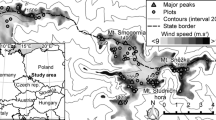Abstract
Wind stress may significantly change plant damage by aerial pollutants. However, almost no information exists on pollution-induced changes in wind regime around the strong emission sources. Wind speed, measured in industrial barrens adjacent to the nickel–copper smelter at Monchegorsk (Kola Peninsula, NW Russia), was two to three times as high as in the slightly polluted and nearly unpolluted forests. The ratio between the maximum wind velocity within 30 s and the average velocity of that time interval showed no temporal variation, thus characterising the wind regime. This ratio was highest in unpolluted forests, suggesting the predominance of gusty winds; in industrial barrens the maximum wind speed was only slightly higher than the average value. Since topography did not explain the spatial variation in wind regime, I conclude that my data represent the first direct evidence for distinct changes in wind regime caused by pollution-induced habitat deterioration. The results suggest that initial (partly pollution-induced) forest disturbance causes secondary effects (like increased snow evaporation, followed by soil freezing and plant damage) that may enhance further disturbance in a positive feedback fashion.
Similar content being viewed by others
Author information
Authors and Affiliations
Corresponding author
Additional information
Electronic Publication
Rights and permissions
About this article
Cite this article
Kozlov, M. Changes in wind regime around a nickel–copper smelter at Monchegorsk, northwestern Russia. Int J Biometeorol 46, 76–80 (2002). https://doi.org/10.1007/s00484-002-0123-5
Received:
Accepted:
Published:
Issue Date:
DOI: https://doi.org/10.1007/s00484-002-0123-5




